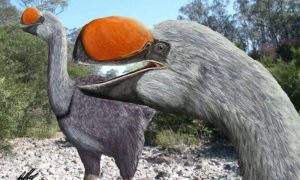
A newly discovered distant relative of the duck has just been hailed as an ancestor of the biggest bird the world has ever known by a group of Australian palaeontologists.
They say Dromornis murrayi, which at 250kg was originally the ‘baby’ of the ancient ‘Mihirung’ family of Dromornis giant birds, eventually evolved into the world’s biggest bird, D. stirtoni, before going extinct.
“It lived in the late Oligocene – early Miocene, and was the first member of the lineage of Dromornis species,” says Dr Trevor Worthy, from Flinders University in South Australia, who led the study.
“Originally, it was the smallest, at a pretty hefty 250 kg, but by eight million years ago it had evolved into D. stirtoni, which averaged a whopping 450 kg – with some individuals reaching 650 kg – the largest birds the world has known.”
Dr Worthy’s team of palaeontologists, from Finders University and University of New South Wales, revealed the news in a study just published in the Journal of Vertebrate Paleontology.
“Mihirungs were giant flightless birds only found in Australia and are known only from fossils,” said Dr Worthy. “The largest stood two metres high at its back and reached well over three metres at the head.
“They survived until the Pleistocene period when Genyornis newtoni, the last species, died out, probably about 50,000 years ago.”
Seven species in four genera of the bird are generally recognised, with the last five named in 1979 by Patricia Vickers Rich, now a Professor at Monash University.
Now, some 37 years later, the naming of the new, and largest, species, Dromornis murrayi, after Peter Murray, former Northern Territory Museum curator and co-author of the book Magnificent Mihirungs, brings the total number of mihirungs known to eight.
“This is one monstrous chook that would have had no trouble kicking anyone’s dunny door down,” said Professor Mike Archer from the University of New South Wales, whose expeditions over many years revealed the new mihirung.
“The very large and distinctive bones of this new ‘Big Bird’ are quite common in the Riversleigh fossil deposits, and are easily spotted by scientists and visitors to the site,” said Professor Suzanne Hand, also from University of New South Wales.
The authors of the study drew their conclusions after examining skull bones, a sternum or breastbone, and bones from the leg and foot.
“We even had some tiny bones of the wing, which showed this gigantic bird had already, by 26 million years ago, essentially lost its wings,” said Dr Worthy.
To assess further how the various mihirungs differed, the team of palaeontologists also looked in detail at their skulls.
“These birds take the prize for those with the weirdest skull. It is like they had run into a brick wall and compressed everything from front to back, so that the bill joined on half way through the eye,” he said.
Note: The above post is reprinted from materials provided by Flinders University.










